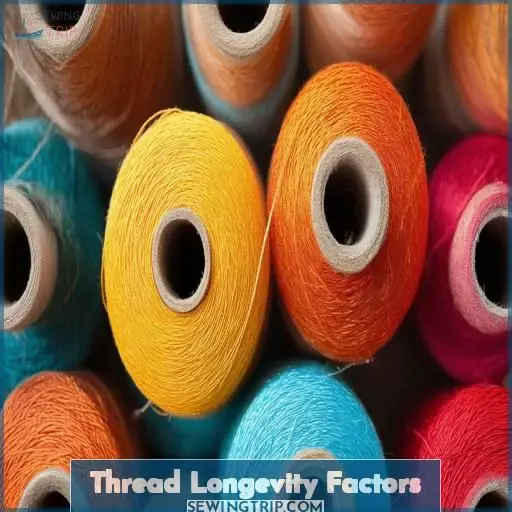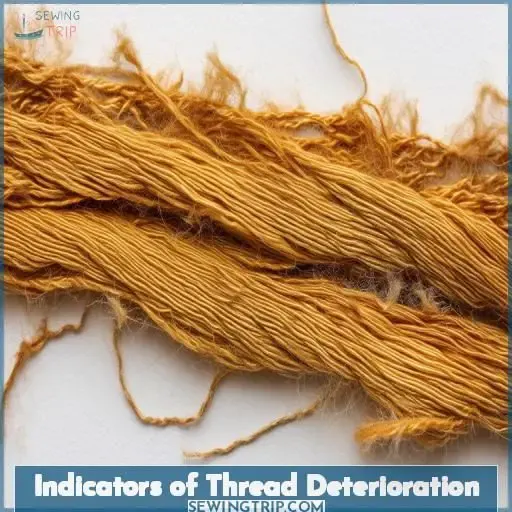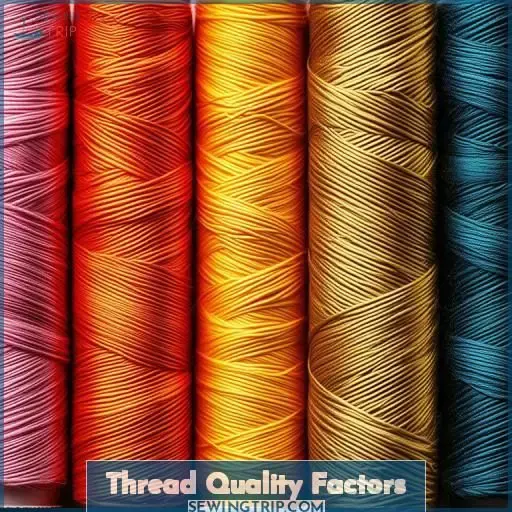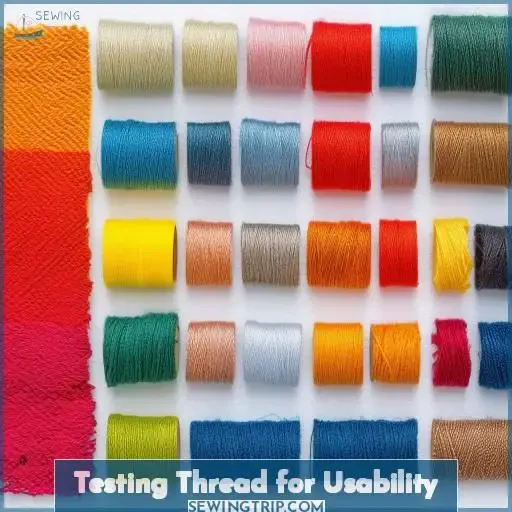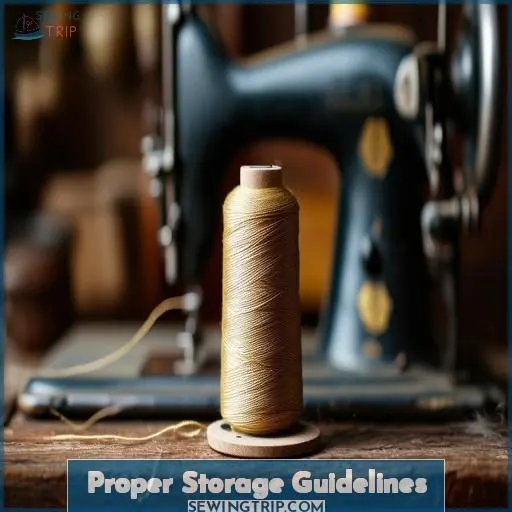This site is supported by our readers. We may earn a commission, at no cost to you, if you purchase through links.
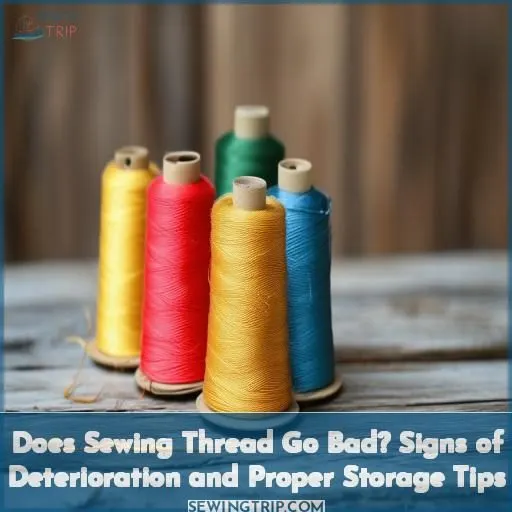 Yes, sewing thread can deteriorate over time if not appropriately cared for.
Yes, sewing thread can deteriorate over time if not appropriately cared for.
Improper storage exposes it to factors such as sunlight, humidity, dryness, and temperature fluctuations that cause fading, stickiness, brittleness, and breakage.
You’ll know it’s deteriorating if it accumulates dust, appears dull or frayed, or has impurities from wood spools.
High-quality polyester thread on plastic spools resists deterioration better than cheaper alternatives.
Test usability by tying a knot and gently tugging—if it snaps, it’s time for new thread.
Moderate temperatures and controlling humidity are key to maximizing your thread’s longevity.
Want to make sure your thread stays in prime condition? Keep reading to learn essential storage tips.
Table Of Contents
Key Takeaways
- Sewing thread is like a fine wine – if you store it improperly, it can turn vinegary and unpalatable. Sunlight, humidity, and temperature swings are the sworn enemies of thread longevity, causing it to fade, stick together, snap, and generally lose its luster.
- When shopping for thread, splurge a little and invest in top-shelf polyester varieties on plastic spools. These bad boys are practically immortal compared to their cotton-coated, wooden spool brethren. It’s like buying a Rolex instead of a Timex – you pay more upfront, but it’ll keep ticking for eons.
- Don’t just blindly trust that dusty old spool of thread you inherited from grandma. Give it the old knot test – if it snaps when you tug gently, send it packing. A frayed, frazzled thread is a stitch away from ruining your latest masterpiece.
- Proper thread care is like the Goldilocks principle – not too hot, not too cold, not too damp. Keep it in a cool, dry place away from sunshine’s harsh rays, and your stitches will stay sturdy and steadfast through thick and thin, year after year.
Does Sewing Thread Go Bad?
Yes, sewing thread can go bad over time. Signs of deterioration include dust accumulation, discoloration, and loss of strength due to improper storage conditions like exposure to sunlight, high humidity, or extreme temperatures.
Thread Longevity Factors
You’ll want to carefully consider several key thread longevity factors that can impact the usability of your sewing thread over time. Piecing and quilting threads can last over 50 years, but improper storage conditions like exposure to sunlight, humidity, dryness, or cold temperatures can drastically reduce the thread’s lifespan by causing fading, stickiness, brittleness, and breakage.
Piecing and Quilting Thread
For piecing and quilting thread, with proper storage, you can expect longevity of 50+ years. High-quality, polyester-coated thread on plastic spools made with newer manufacturing technology offers exceptional durability. However, be wary of cheaper threads with cotton coatings or wood/Styrofoam spools, as these deteriorate faster.
Improper Storage
You’re risking thread discoloration, fraying, stretching, knotting, and breakage if you improperly store it. Fluctuating temperatures and humidity levels can wreak havoc, causing even high-quality thread to deteriorate prematurely. To test if your thread’s still usable, cut a 12" length, tie a knot in the center, and gently tug from both ends—breakage means it’s done for.
Sunlight
You’ll want to avoid exposing your thread to sunlight, as UV exposure can lead to fading colors and weakening of fibers over time. Direct sunlight accelerates this damage, causing your vibrant threads to lose their rich hues and become brittle. Keep your thread stash tucked away from windows and other UV sources to prevent unsightly color loss and fabric damage.
Humidity
In addition to sunlight, you must also be wary of humidity’s effects on your thread. Excessive moisture can cause:
- Stickiness and thickening
- Thread coatings to degrade
- Accelerated mold growth
- Weakened tensile strength
- An acidic environment
Proper humidity control is essential for preserving your thread’s longevity and performance.
Dryness or Cold
Excessive dryness or frigid cold temperatures can also wreak havoc on thread. You’ll notice thread embrittlement – fibers become stiff and brittle, snapping easily under tension. Fluctuating temperatures intensify this brittleness, so aim for moderate, stable conditions. Proper storage in plastic spools away from harsh elements is key to preserving thread quality long-term.
Indicators of Thread Deterioration
When examining your sewing thread for signs of deterioration, be on the lookout for dust accumulation, as this can indicate that the thread is old and neglected. Additionally, cheap thread, cotton coatings, wood or Styrofoam spools, and old manufacturing dates are all potential red flags that the thread may be nearing the end of its usable lifespan.
Dust Accumulation
Dust accumulation on thread is a telltale sign it’s gone bad. Don’t overlook that dusty cotton coating or those old wood spools gathering grime in your sewing basket. Aging thread acts like a magnet for particles, pointing to deterioration. Even if the manufacturing date seems recent, thread quality matters – cheap thread invites dust faster.
Cheap Thread
You’ll also want to watch out for cheap, thin thread that’s prone to weakness and fraying. These threads often:
- Discolor or appear dull
- Break easily under tension
- Unravel and shed fibers
Low-quality threads simply don’t have the durability for long-term use. Invest in quality polyester or cotton-wrapped polyester threads from reputable brands for the best results.
Cotton Coating
Another indicator of thread deterioration is cotton coating. Cotton threads are made from natural fibers that can degrade over time, leading to dye bleed, fraying, and lint accumulation. Here’s a quick breakdown:
| Thread Type | Coating | Longevity | Signs of Deterioration |
|---|---|---|---|
| Cotton | Natural | Shorter | Dye bleed, fraying |
| Polyester | Synthetic | Longer | Minimal issues |
Cotton threads require extra care to maintain their quality and usability.
Wood or Styrofoam Spools
You’ll want to keep an eye out for wood or styrofoam spools – they’re an indicator that your thread might be past its prime. Over time, these materials can transfer impurities to the thread, causing discoloration or weakening. Opt for plastic alternatives instead; they’ll guarantee your stitches stay strong and true for years to come.
Old Manufacturing Dates
While those old wooden or styrofoam spools might have a vintage charm, they’re often a telltale sign that the thread is past its prime.
Vintage spools or discontinued brands can be risky, as manufacturing technologies have improved over time for greater durability.
If the spool’s date shows the thread is decades old, consult online thread databases to compare its expected lifespan against modern options.
Thread Quality Factors
When selecting sewing thread, you’ll want to prioritize quality factors like polyester coating, plastic spools, and newer manufacturing technology – these elements enhance durability and longevity. High-quality thread from reputable brands, coupled with proper storage practices like avoiding sunlight and controlling humidity, can markedly extend the usable lifespan of your thread.
Polyester Coating
You’ll get the most longevity from threads with a polyester coating. Thanks to synthetic fibers and advanced manufacturing techniques, polyester-coated threads boast superior durability compared to cotton or uncoated alternatives. Proper storage is still key though – even the best polyester threads will eventually degrade if exposed to sunlight, humidity, or extreme temperatures.
Plastic Spools
Along with polyester coatings, you’ll find that plastic spools offer longevity benefits for your thread. These smooth, non-porous spools protect your thread from dust, moisture, and other environmental factors that contribute to deterioration. Plus, plastic spools provide convenient storage options, helping prevent tangles and preserving thread quality over time.
High-Quality Thread
You’ll want to invest in high-quality thread for superior longevity and durability. Premium threads resist dust, fading, and breakage far better than lower-quality alternatives. Consider reputable brands that emphasize thread characteristics like polyester-coating and consistent performance over extended periods. Quality thread may cost more upfront but yields benefits in reliable stitching results.
Newer Manufacturing Technology
You’ll find that newer manufacturing technology enhances thread durability. Innovative techniques like:
- Advanced polymer coatings
- Precise fiber alignment
- Optimized spinning processes
- Improved quality control
…result in higher-quality threads with better longevity. Expect technological improvements to further boost thread performance in the future.
Proper Storage
Taking proper storage seriously will keep your thread in pristine condition. Maintain moderate temperatures, and control humidity to prevent stickiness or brittleness. Keep spools clean and protected from dust. An organized system helps track storage duration. Implement these tips, and your thread will last for years, ensuring consistent stitch quality.
Testing Thread for Usability
To test if your sewing thread is still usable, cut a 12-inch length and tie a knot in the center. Then, gently pull the thread from both ends – if it breaks or tears, the thread has deteriorated and should be replaced, but if it holds without breaking, it’s still in good condition to use.
Cut 12 Thread
To test your thread’s longevity, grab a 12-inch length and set your machine’s tension to average. A simple yet essential step, this lets you evaluate the thread’s integrity before it fails mid-project. Don’t risk ruining your hard work—take a minute to snip and test. After all, a stitch in time saves nine!
Tie Knot in Center
Next, tie a knot precisely in the center of your 12" thread. A simple overhand knot will do:
- Form a loop
- Pass the ends through the loop
- Pull tight
The knot’s strength, security, positioning, appearance, and type all matter for an accurate test. Tying the knot centrally guarantees even tension from both sides when pulling.
Pull Gently From Both Ends
After tying the knot, gently pull the thread ends in opposite directions. Observe the thread’s strength as you stretch it taut – does it feel sturdy or weak? Notice any change in thickness or elasticity. High-quality thread resists fraying and retains its colorfastness when pulled. This simple test gauges the thread’s overall integrity.
Breakage or Tearing
If the thread breaks or tears as you gently pull from both ends, it’s a clear sign the thread has lost its strength and durability over time.
Reasons can include age, improper storage exposing it to sunlight or humidity, or simply a lower-quality thread to begin with.
In any case, discard this thread – its lack of tensile strength makes it unfit for sewing projects.
No Breakage
If your thread doesn’t break, it’s still in good shape. But don’t stop there – you should:
- Check for discoloration
- Feel for stiffness or brittleness
- Inspect for dust or debris
- Consider the thread’s age
Even if it doesn’t snap, old thread can cause problems like skipped stitches or tangling. With proper storage and quality thread, you can keep your stitches strong and your projects looking sharp.
Proper Storage Guidelines
You’ll want to avoid exposing your thread to direct sunlight, as UV rays can cause fading and weakening over time. Additionally, controlling humidity levels in your storage area is essential; excessive moisture can lead to stickiness and thickening of the thread, while extreme dryness may result in brittleness and breakage.
Avoid Sunlight
You’ll want to keep your thread away from direct sunlight to prevent UV damage and fading concerns. Sunlight exposure can cause discoloration and weaken the fibers over time, so optimize storage by keeping your thread in a cool, dark place. Protecting it from sunlight is key to maintaining its quality and vibrant colors.
Control Humidity
You’ll also want to control humidity levels when storing thread. Humidity can make thread sticky and thick, impacting its performance. Hygroscopic threads readily absorb moisture from the environment, leading to deterioration over time. Maintain moderate humidity around 40-60% to preserve your thread’s quality and longevity.
Choose Plastic Spools
You’ll want to opt for plastic spools when storing thread long-term. Plastic offers superior durability and longevity, protecting your precious threads from environmental factors that can degrade quality over time. Plastic spools aren’t just cost-effective for storage, but they’re also eco-friendly compared to wooden alternatives. This simple choice maximizes thread life while minimizing environmental impact.
Moderate Temperatures
Preserving thread longevity requires storing it at moderate temperatures. Storing in extreme heat or cold can lead to brittleness and breakage. Aim for an ideal range of 65°F to 75°F (18°C to 24°C). High temps accelerate chemical breakdown, while freezing causes fibers to stiffen. A climate-controlled area prevents issues caused by temperature fluctuations.
Keep Thread Clean
You’ll want to keep your thread clean for maximum longevity. Here are 4 tips:
- Store spools in airtight containers to prevent dust buildup.
- Avoid touching thread excessively with bare hands to prevent oil transfer.
- Clean plastic spools periodically with a dry, lint-free cloth.
- Consider utilizing thread storage boxes designed for excellent organization and protection.
Maintaining proper thread hygiene ensures your supplies remain vibrant and tangle-free for years to come.
Frequently Asked Questions (FAQs)
Can sewing thread be recycled or repurposed?
Yes, you can repurpose old sewing thread for crafts or artsy projects like making decorative tassels or embroidery. However, recycling isn’t practical due to thread’s small size and mixed material composition.
What are eco-friendly alternatives to traditional threads?
Let’s explore guilt-free stitching! Eco-friendly threads like organic cotton, bamboo, or recycled fibers offer sustainable alternatives to conventional options. By choosing wisely, your projects can harmonize with nature’s rhythm.
How does thread affect fabric drape and handfeel?
Fine threads drape beautifully, enhancing fabric handfeel. Coarse threads cause stiffness and roughness. Choose quality polyester threads for ideal drape and smooth, luxurious handfeel in your sewn projects.
Are there thread options suitable for high-heat applications?
Like fire and ice, some threads withstand scorching temps. High-heat polyester and aramid threads soldier on where cotton fears to tread. Exploring industrial sewing demands special threads – your fabric’s bodyguard against searing conditions.
What precautions should be taken when sewing activewear?
For activewear, use polyester thread designed for stretchy fabrics. Slightly loosen tension to allow stitches flexibility. Test stitching on scrap fabric first.
Conclusion
Forsooth, ensuring your sewing thread doesn’t go bad hinges on proper storage practices. Select premium polyester thread on plastic spools and avoid sunlight, humidity extremes, and temperature fluctuations. Regularly assess thread condition by tying knots and gently pulling—if it snaps, discard and replace it. Controlling these factors maximizes longevity, so you can sew with confidence.

